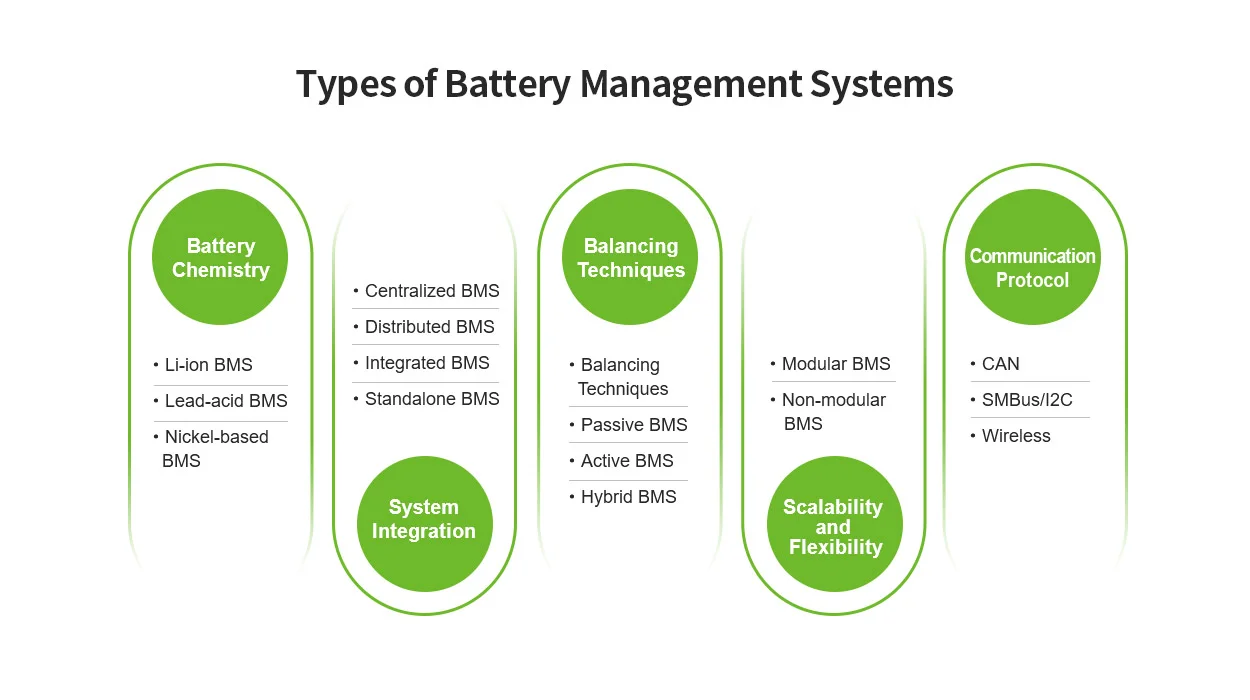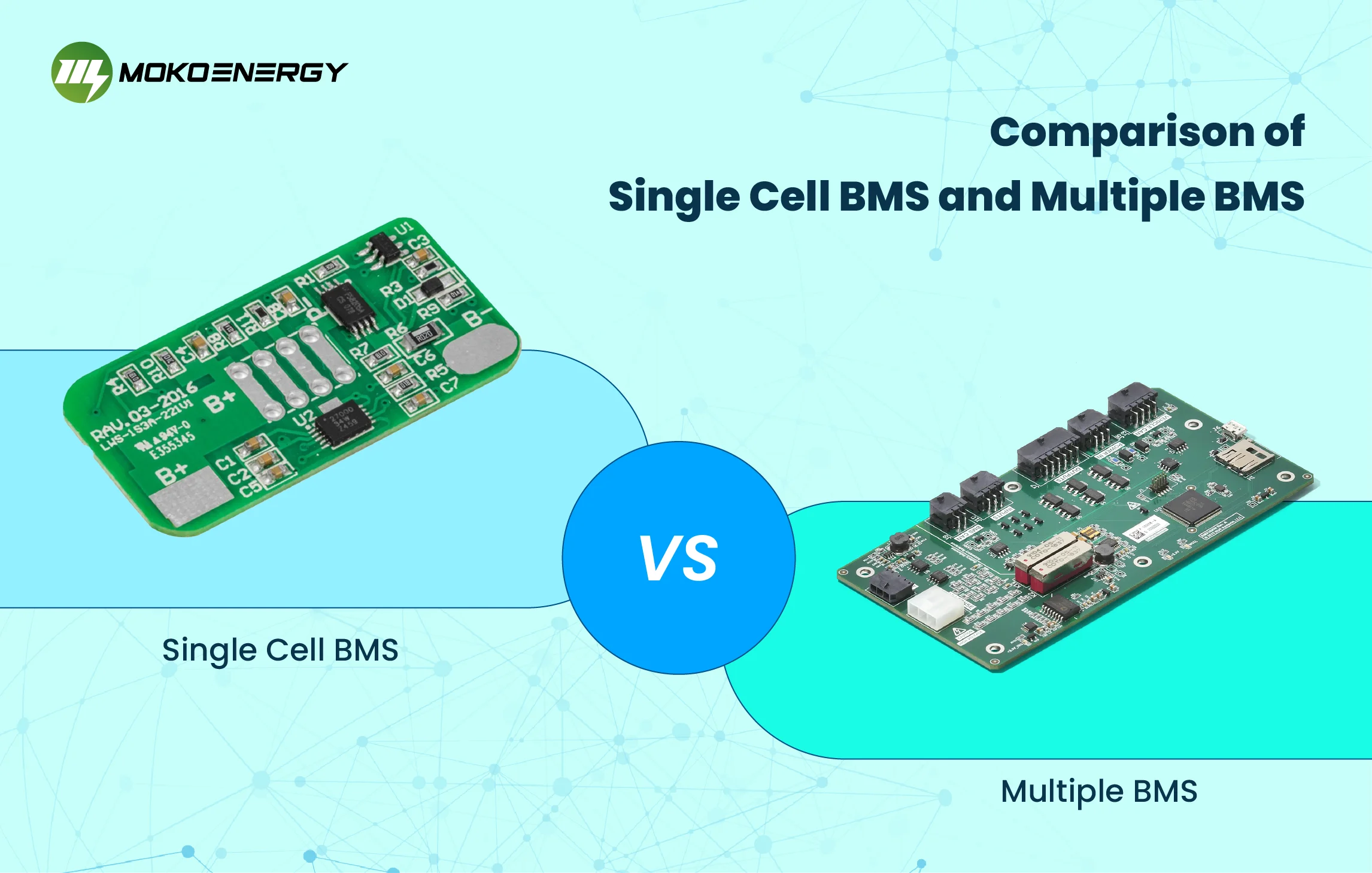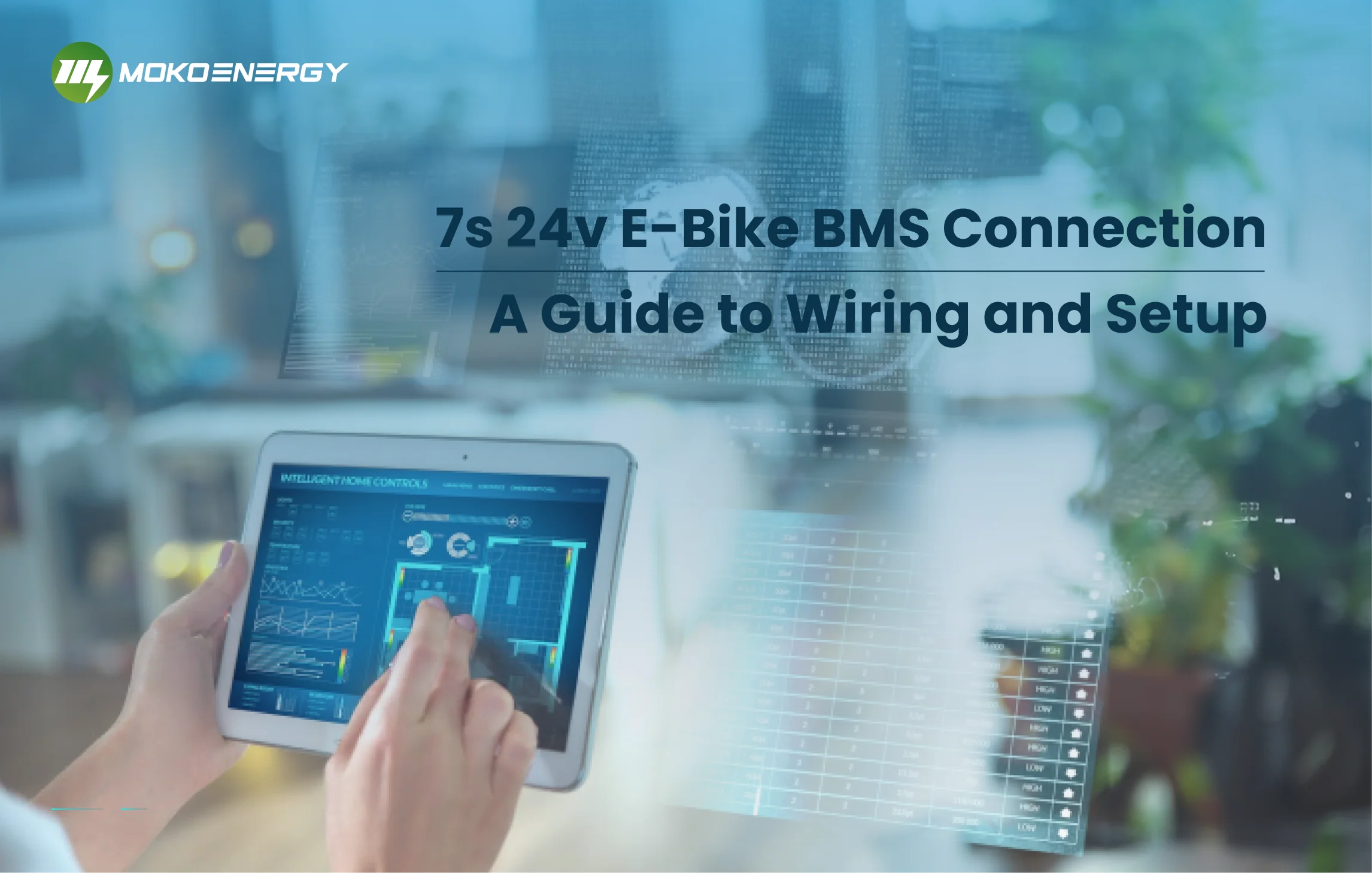Battery Management System (BMS) plays an essential role in optimizing the performance, safety, and lifespan of batteries in various applications. Selecting the appropriate BMS is essential for effective energy storage, cell balancing, State of Charge (SoC) and State of Health (SoH) monitoring, and seamless integration with different battery chemistries. This article aims to provide a detailed overview of the different types of Battery Management Systems based on five key categories, along with a comprehensive comparison and guidance on selecting the most suitable BMS for specific requirements. Additionally, we will explore Mokoenergy’s extensive range of BMS solutions and highlight their capabilities in the field.
Types of Battery Management Systems
Battery Management Systems can be categorized based on Battery Chemistry as follows: Lithium battery, Lead-acid, and Nickel-based. Based on System Integration, there are Centralized BMS, Distributed BMS, Integrated BMS, and Standalone BMS. Balancing Techniques are categorized into Hybrid BMS, Active BMS, and Passive BMS. Scalability and Flexibility divide them into Modular BMS and Non-modular BMS. Lastly, Communication Protocol categories include CAN (Controller Area Network), SMBus/I2C, and Wireless.
Based on Battery Chemistry: Li-ion BMS, Lead-acid BMS, and Nickel-based BMS
- Li-ion BMS
Li-ion BMS is specifically designed for Li-ion battery chemistries, which are widely used in applications such as electric vehicles, portable electronics, and renewable energy systems. These BMS units employ sophisticated algorithms to monitor cell voltages, temperatures, and currents. They provide precise SoC and SoH estimation, overvoltage and undervoltage protection, battery thermal management, and cell balancing functionality. Li-ion BMS solutions offer high energy density, lightweight construction, longer cycle life, and fast charging capabilities. However, they require complex algorithms and meticulous safety measures due to the sensitivity of Li-ion batteries to overcharging and over-discharging.
- Lead-acid BMS
Lead-acid BMS solutions are optimized for lead-acid batteries commonly used in automotive, telecommunications, and stationary power applications. These BMS units monitor parameters such as temperature, battery voltage, and current. They offer overvoltage and undervoltage protection, temperature compensation, and equalization charging. Lead-acid BMS solutions are known for their cost-effectiveness, robustness, reliability, and well-established technology. However, lead-acid batteries have limited energy density, shorter cycle life, and slower charging capabilities compared to Li-ion batteries.
- Nickel-based BMS
Nickel-based BMS solutions are tailored for nickel-based battery chemistries such as Nickel-Metal Hydride (NiMH) and nickel-cadmium (Ni-Cd). These BMS units monitor parameters like cell voltage, temperature, and current. They incorporate features like overcharge and over-discharge protection, temperature sensing, and battery charger termination control. Nickel-based batteries offer advantages such as high energy density, reliable performance, and good operation at high temperatures. However, they have limitations, including limited cycle life, memory effect in Ni-Cd batteries, and sensitivity to overcharging.
Based on System Integration: Centralized BMS, Distributed BMS, Integrated BMS, and Standalone BMS
- Centralized BMS
Centralized BMS architecture involves a single BMS unit responsible for monitoring and managing multiple batteries or cells within a system. It simplifies wiring, reduces cost, and provides centralized control and monitoring capabilities. Centralized BMS solutions are widely used in applications like electric vehicles, grid energy storage, and industrial systems. They offer scalability, ease of maintenance, and the ability to monitor the overall system’s performance. However, they introduce a single point of failure and may require complex communication protocols for data exchange.
- Distributed BMS
Distributed BMS architecture utilizes multiple BMS units distributed throughout a system, with each unit responsible for monitoring and managing a specific battery or cell. This decentralized approach provides redundancy, improved fault tolerance, and scalability. Distributed BMS solutions are commonly used in large battery packs or systems where individual cell monitoring is crucial. They offer enhanced safety, localized control, and the ability to address individual cell variations effectively. However, distributed BMS solutions require complex wiring, increased cost, and potentially complicated data synchronization between the distributed units.
- Integrated BMS
Integrated BMS refers to BMS functions integrated into the battery pack itself, typically embedded within a dedicated microcontroller or microprocessor. This integration offers a compact and streamlined solution, reducing wiring complexity and external components of the battery management system. Integrated BMS solutions are commonly found in small-scale consumer electronics, electric bicycles, and some Li-ion battery packs. They provide a plug-and-play approach, simplified installation, and enhanced safety through integrated protection mechanisms. However, integrated BMS solutions may lack flexibility for customization, upgradeability, and compatibility with different battery chemistries or pack configurations.
- Standalone BMS
Standalone BMS units are independent of the battery pack and are connected to it via communication interfaces. They provide a versatile and adaptable solution applicable to various battery chemistries and configurations. Standalone BMS solutions offer flexibility, compatibility with different battery management algorithms, and the ability to retrofit existing battery systems. They are commonly used in retrofitting projects, custom battery packs, and applications where integration with the battery pack is not feasible. However, standalone BMS units require additional wiring and may incur higher installation and maintenance costs.
Based on Balancing Techniques: Passive BMS, Active BMS, and Hybrid BMS
- Passive BMS
Passive balancing is a technique that balances cells by dissipating excess charge as heat, without actively controlling charging or discharging. Passive balancing is a simple and cost-effective solution that works well for applications with lower voltage differences between cells. It is commonly used in lead-acid batteries and some Li-ion battery packs. Passive BMS does not require additional components or complex control algorithms, but it may lead to energy loss and increased system temperature.
- Active BMS
Active balancing involves actively redistributing charges between cells to ensure uniform voltage levels. Active balancing improves cell performance, maximizes battery capacity utilization, and prolongs battery life. It is particularly effective for Li-ion battery packs with high-voltage differences between cells. Active BMS requires additional battery management system circuits, control algorithms, and power electronics to transfer energy between cells. It offers precise balancing control, reduced energy loss, and improved overall system efficiency.
- Hybrid BMS
Hybrid balancing utilizes a combination of passive and active balancing techniques. It offers the benefits of both methods, providing efficient balancing, improved cell performance, and extended battery life. Hybrid balancing strikes a balance between cost, complexity, and effectiveness. It is commonly employed in Li-ion battery packs where cells exhibit different voltage characteristics. Hybrid BMS optimizes balancing efficiency while minimizing energy loss and system complexity.
Based on Scalability and Flexibility: Modular BMS, and Non-modular BMS
- Modular BMS
Modular BMS consists of multiple BMS units that can be easily interconnected or disconnected to accommodate various battery configurations. It offers flexibility in battery pack design, scalability, easy maintenance, and system expansion. Modular BMS solutions allow for the addition or removal of BMS units based on the specific battery management system requirements. They are commonly used in applications with changing battery configurations or when flexibility and modularity are desired. However, modular BMS solutions may require additional wiring and incur higher initial costs.
- Non-modular BMS
Non-modular BMS configurations are designed for specific battery pack sizes or configurations and have a fixed BMS configuration. They offer simplicity, cost-effectiveness, and streamlined integration. Non-modular BMS solutions are suitable for applications where the battery pack size and configuration remain constant. They eliminate the need for additional wiring and provide a straightforward solution. However, non-modular BMS solutions may lack flexibility for future upgrades or changes in battery pack configurations.
Based on Communication Protocol: CAN BMS, SMBus/I2C BMS, and Wireless BMS
- CAN (Controller Area Network) BMS
CAN BMS employs the CAN bus communication protocol, commonly used in industrial and automotive applications. It provides reliable communication, high data transfer rates, and robust error-handling capabilities. CAN BMS enables seamless integration with other CAN-enabled devices and allows for real-time monitoring and control. It is suitable for applications requiring high reliability, noise immunity, and scalability. However, CAN BMS may require additional wiring, and compatibility with existing systems using different communication protocols may require additional interfaces.
- SMBus/I2C BMS
I2C (Inter-Integrated Circuit) and SMBus (System Management Bus) are communication protocols commonly used in consumer electronics and smaller-scale applications. SMBus/I2C BMS solutions offer simplicity, low power consumption, and ease of implementation. They allow for efficient communication between the BMS and other devices in the system. SMBus/I2C BMS is suitable for applications with lower data transfer requirements and simpler system architectures. However, it may have limitations in terms of data transfer speed and scalability for larger-scale systems.
- Wireless BMS
Wireless BMS incorporates wireless communication technologies such as Wi-Fi or Bluetooth for data transmission and control. It provides the advantage of eliminating the need for physical wiring connections between the BMS and the battery pack or other devices. Wireless BMS allows for remote monitoring, diagnostics, and control, enhancing convenience and flexibility. It is commonly used in applications where physical connections are challenging, such as electric vehicles or distributed energy storage systems. However, wireless BMS may introduce additional complexity in terms of data security, reliability in harsh environments, and power consumption.

Compare Different Types of Battery Management Systems in a Table
| CATEGORY | LITHIUM-ION BMS | LEAD-ACID BMS | NICKEL-BASED BMS | CENTRALIZED BMS | DISTRIBUTED BMS |
|---|---|---|---|---|---|
| Applications | Electric vehicles, portable electronics, renewable energy systems, grid energy storage | Automotive, telecommunications, UPS (uninterruptible power supply) systems, stationary power applications | Emergency lighting, medical equipment, aviation, railway systems | Large-scale energy storage systems, electric vehicles with a single battery pack | Electric vehicles with multiple battery packs, large-scale energy storage systems with distributed battery modules |
| Usage | Monitors cell voltage, temperature, and current; controls charging and discharging; protects against faults | Monitors cell voltage, temperature, and state of charge; controls charging and discharging; ensures equalization of battery cells | Monitors cell voltage, temperature, and state of charge; controls charging and discharging; ensures equalization of battery cells | Monitors and manages multiple batteries or cells in a centralized location | Monitors and manages specific batteries or cells distributed throughout a system |
| Advantages | High energy density, longer cycle life, lightweight, fast charging, high power output | Cost-effective, robust, reliable, long service life, wide operating temperature range | High energy density, good performance in extreme temperatures, long service life | Simplified wiring, reduced component duplication, centralized monitoring and management of multiple batteries | Enhanced fault tolerance, scalability, localized monitoring, and management of specific batteries or cells |
| Disadvantages | Sensitive to overcharging, overheating, and deep discharging; requires complex protection circuitry | Heavyweight, low energy density, limited cycle life, longer charging time | Limited energy density, memory effect in Nickel-Cadmium batteries | Potential single point of failure, increased wiring complexity, limited flexibility in battery pack configurations | Complex communication and synchronization between distributed units, increased wiring complexity, and potential for communication delays |
| Voltage Range | Wide range of operating voltages | Limited operating voltage range | Limited operating voltage range | Wide range of operating voltages | Wide range of operating voltages |
| System Cost | Moderate to high-cost | Relatively low cost | Moderate to high-cost | Moderate to high-cost | Moderate to high-cost |
| Safety Features | Comprehensive protection features against overcharging, over-discharging, and overheating | Basic protection features against overcharging and over-discharging | Basic protection features against overcharging and over-discharging | Basic protection features against overcharging and over-discharging | Basic protection features against overcharging and over-discharging |
| Cell Balancing | Active balancing technology to ensure uniform voltage levels among cells | The passive balancing method dissipates excess charge as heat | Hybrid balancing technique utilizing a combination of passive and active balancing methods | Passive balancing | Active balancing method |
Factors to Consider When Choosing the Right Types of Battery Management System
Selecting the appropriate Battery Management System (BMS) is crucial for ensuring the optimal performance, safety, and longevity of your battery system. When choosing a BMS, consider the following factors to make an informed decision:
Battery Chemistry Compatibility: Different battery chemistries require specific BMS functionalities. Ensure that the BMS you choose is designed for your battery chemistry, such as Li-ion, lead-acid, or nickel-based batteries. Verify that the BMS can accurately monitor the parameters and implement necessary safety measures for your specific battery chemistry.
System Integration: Determine the level of system integration required for your application. Assess whether a centralized, distributed, integrated, or standalone BMS architecture aligns with your system’s needs. Centralized BMS offers simplified wiring and centralized control, while distributed BMS provides redundancy and localized control. Integrated BMS is embedded within the battery pack, streamlining installation, while standalone BMS offers versatility and compatibility with various battery configurations.
Balancing Technique: Evaluate the balancing technique offered by the BMS. Active balancing redistributes charge between cells to ensure uniform voltage levels, while passive balancing dissipates excess charge as heat. Hybrid balancing combines both techniques for efficient balancing. Consider the voltage differences between cells and the desired balancing efficiency to choose the appropriate technique.
Scalability and Flexibility: Determine whether a modular or non-modular BMS suits your requirements. A modular BMS allows for easy expansion, customization, and accommodation of different battery configurations. Non-modular BMS offers a fixed configuration, suitable for applications with consistent battery pack sizes and configurations.
Communication Protocol: Consider the communication protocol supported by the BMS. CAN, SMBus/I2C, and wireless protocols each have their advantages. CAN provides reliable communication, high data transfer rates, and robust error handling, making it suitable for automotive and industrial applications. SMBus/I2C is simpler and more power-efficient, commonly used in consumer electronics. Wireless communication offers flexibility and remote monitoring capabilities, ideal for applications where physical connections are challenging.
Safety and Protection: Prioritize the safety features offered by the BMS, such as over-discharge protection, overcharge protection, temperature monitoring, and short-circuit protection. Ensure that the BMS adheres to relevant safety standards and provides comprehensive protection mechanisms for your battery system.
Technical Support: Consider the availability of after-sales services and technical support provided by the BMS manufacturer. Ensure that they offer reliable customer support, documentation, and software/firmware updates to address any potential issues or system upgrades.
Consulting with experts and BMS providers, evaluating product specifications, and conducting thorough research will help you make an informed decision when selecting the right BMS for your specific application.

MOKOEnergy’s Types of Battery Management System
MOKOEnergy specializes in providing comprehensive BMS solutions tailored to various applications. Our BMS offerings include:
- Li-ion BMS: Designed specifically for Li-ion battery chemistries, our Li-ion BMS provides precise monitoring, cell balancing, and comprehensive protection features, ensuring optimal performance and safety.
- Modular BMS: Our modular BMS solutions offer flexibility, scalability, and easy customization to accommodate different battery pack configurations. They simplify system integration, maintenance, and future upgrades.
- Active Balancing: Our BMS units utilize active balancing technology to ensure uniform voltage levels among cells, maximizing battery capacity and extending battery life.
- Communication Options: Mokoenergy’s BMS solutions support various communication protocols, including CAN and wireless options. This enables seamless integration and reliable data transmission and control capabilities.
MOKOEnergy serves a wide range of industries including automotive, energy storage, telecommunications, consumer electronics, and renewable energy. Our BMS solutions are suitable for applications such as electric vehicles, grid storage systems, UPS systems, power tools, and more.
Conclusion
Choosing the right Battery Management System is crucial for achieving optimal performance, safety, and longevity of battery systems. By considering factors such as battery chemistry, system integration, balancing technique, and communication options, you can make an informed decision.
MOKOEnergy provides a wide range of BMS solutions tailored to meet the specific needs of different industries. Our Li-ion BMS, modular design options, active balancing technology, and support for various communication protocols make us a trusted partner in delivering reliable BMS solutions. Partnering with MOKOEnergy means gaining access to our expertise, comprehensive technical support, and commitment to customer satisfaction. We are dedicated to empowering our customers with the knowledge and resources they need to maximize the performance and lifespan of the battery systems. If you need any assistance, feel free to contact us anytime!
CONTINUE READING ABOUT THE BATTERY MANAGEMENT SYSTEM






